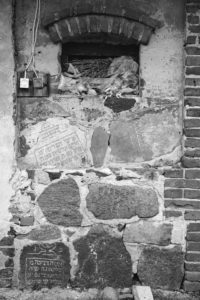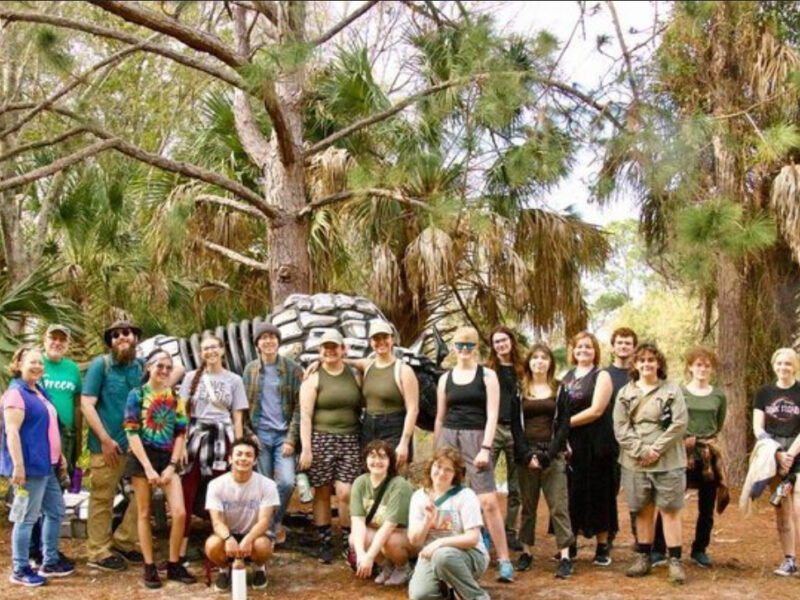Imagine the history of your people being erased one headstone at a time.
At the Florida Holocaust Museum’s latest exhibit, you don’t have to imagine too hard. It is right there on full display.

From 2008 to 2012, photographer Lukasz Baksik traveled all across his home country of Poland to ensure that certain memories are never forgotten. He set out to document a disturbing, but surprisingly common phenomenon: the use and misuse of Jewish gravestones in everyday ways.
The culmination of this work can be seen in the new exhibit, Matzevot For Everyday Use.
The exhibit, which opened on Oct. 15 and will run until Jan. 29, is a series of black-and-white photographs that showcase the multitude of ways in which matzevot, the Hebrew word for gravestone, have been abused over the years.
Recycled into Catholic gravestones, used to patch roadways, courtyards and walls – any role that could be filled by an ordinary rock has, in many cases, been filled by matzevot.
“It’s one of those little-told things that happened,” said Erin Blankenship, the curator of the exhibit.
Blankenship, Baksik and the Florida Holocaust Museum seek to change that.
“We’re trying to shine a light on this and show that it’s not right,” Blankenship explained.
She said that the practice started with Nazi Germany in an attempt to further attack Jewish culture, but has since continued after the war. While malicious intent surely plays some role, it is a problem that was likely compounded in the post-war economy and a need for building material.
“These are stone. They’re made to last. Unfortunately, that is the same material they build with. What they saw as material was there, and people used it. But these stones, in some ways, are the only evidence that these people existed,” Blankenship said.
That being said, Blankenship pointed out a horrible disparity.
“It happened to Jewish gravestones, not to Polish gravestones. Because there was nobody left to care for the cemeteries and speak for them. Nobody there to leave flowers on their loved ones’ graves. In a way, it’s the erasing of a culture,” she said.
Over the years this fact has somehow gotten lost. To this day it remains a little-known consequence of World War II. For many people who now own property that contains matzevot, the potential for an ethical dilemma is instead dominated by the ins and outs of daily life.
“So many people that have them in their house or their yard don’t even think about it,” Blankenship said.
There’s no easy fix. Many of these people are not well-off and are in no financial position to rebuild a roadway for any other reason than functionality.
But a graveyard is not a quarry. These are people’s ancestors. Now they are basketball courts and sandboxes on a children’s playground. Now they serve as grindstones for sharpening tools; a stone that, in performing its sole function, defaces itself. In this case, desecration.
In an interview with Urszula Szczepinska, the curator of education and director of research at the museum, Baksik revealed the question he asked each individual when searching for the matzevot.
“‘Do you think it’s okay to walk on someone’s gravestone?’ Usually, they said they had never thought of that. I don’t think I heard a single different answer,” Baksik said.
He also had a follow-up question.
“So then I would ask if they would like it if someone walked on the gravestone of their grandmother or grandfather. The answer was always the same — that they wouldn’t want it. For these people it was a dramatic question because they would realize they were walking on someone’s gravestone,” he said.
Initially, Baksik set out on his quest to ensure the return of all matzevot to their proper locations, but after his journey, it became clear that the answer wasn’t so simple.
“To my surprise, those interactions were mostly positive. I think it’s because I changed my attitude at a certain point and stopped judging these people. What helped me was the realization that I was not dealing with those that stole the matzevot themselves,” he said in his interview with Szczepinska.
This is a real issue with no easy fix. But Matzevot For Everyday Use ignites a powerful dialogue.
This is the first time this exhibit has been brought to the States. Before it had been shown in Poland and Belarus.
While there are currently no concrete plans for after the exhibit runs, Blankenship pointed out that the prints are theirs to keep, and explained that the museum hopes to take the gallery on the road and have it travel to other museums and photo galleries to further highlight the issue.
The Florida Holocaust Museum is open from 10 a.m. to 5 p.m. everyday and is located at 55 5th St S, St. Petersburg, Fl 33701. Active U.S. military, FHM members and USF students (with ID) all get in for free.



